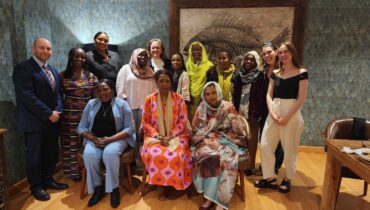The regulation of the nexus between women, peace, and security is the responsibility of a number of international institutions and mechanisms. Encompassing laws, treaties, resolutions, and recommendations, this increasingly interconnected network aims to codify the important role of women in creating, sustaining, and promoting peace. But as this network continues to spread and mix rapidly, what do we really know about it? What are the most important things to know about international laws and institutions on women, peace, and security?
The most important thing to know is that UN Security Council Resolution 1325, unanimously adopted in 2000, is the foundation of the network. It reaffirms these important roles women serve in preventing, mitigating, and resolving conflicts and building, leading, and keeping peace. The specific language encourages all relevant actors to put women in these roles. Furthermore, it highlights how women are of course victims in conflict too—and how important it is for both the UN and its member states to protect them from gender-specific violence. UNSCR 1325 is the product of many coordinating agencies and observers across and outside of the UN system—from United Nations Fund for Women, to the Women’s International League for Peace and Freedom, to International Alert—and has generated significant discussion and even another resolution on its mission, its progress, and its future in the twelve years since its adoption.
But UNSCR 1325 is nowhere near the end of the story on instruments. Its immediate successor was the sequence of UNSC Resolutions 1820and 1888 adopted in 2008 and 2009 respectively, which focused on the specific prevalence of gender-based sexual violence during times of war. By highlighting this specific issue, these resolutions aimed to define and conquer a very real element of UNSCR 1325’s overall mission. They focus on broad spectrums both in effects of this kind of violence and in how to address it; considering the experiences that range from a broken woman to an exacerbated conflict, the resolutions propose strengthening mechanisms like advocacy, accountability, and participation. Most importantly, they have garnered significant international support from inter-governmental and non-governmental organizations, further widening and deepening the impact of international instruments for women, peace, and security.
With the knowledge of this set of UN resolutions alone, the picture of progress thus far on women and security is a slow but steady one—one recent large and general decree on the importance of women, followed by one more-recent tailored decree on the importance of women relative to one specific issue. They are seemingly slow (but historically fast) and steady developments relative to women, peace, and security that should engender continued developments. But just because these resolutions pioneered the exploration of this intersection does not mean they have ownership of this broad field. Some of the most important things to know about international instruments on women, peace, and security occur in the margins; these threads are perhaps finer, but are just as strong in building the web of international regulation on the role of women in peace and conflict.
Consider the Arms Trade Treaty, an in-progress collaboration of governments attempting to establish a legally binding instrument for standards relative to the international trade of conventional arms. Arms transfers and, particularly, the risk that said transfers are made inappropriately obviously have a large impact on the prevalence of violence against all humans, men and women alike. Gender could potentially be relegated to the back-seat on such an agreement. Yet, as this treaty is negotiated, several groups are emphasizing that the treaty should include explicit provisions requiring states not to allow “an international transfer of conventional arms when there is a substantial risk that the arms under consideration are likely to be used to perpetrate or facilitate acts of gender-based violence, including rape and other forms of sexual violence.” (PeaceWomen 2012) In this kind of instrument, gender is not the reason it is being established, but it is a central pillar to what it aims to accomplish.
The debate over the Arms Trade Treaty and other issues—the open debate on the Protection of Civilians in Armed Conflict, the Human Rights Council’s debate on human rights independent of sexual orientation—all show that the web of international institutions relative to women, peace, and security is more than just a set of roots. Rather, the root resolutions of the Security Council are continuing to spawn independent institutions and mechanisms that grow from and incorporate a gender perspective. There is a great deal of work that must continue to be done, but women’s impact is no longer being treated separately from other important issues of conflict and its resolution.
Thus, the most important thing to know about international institutions on women peace and security? They are no longer just on women, peace, and security. Gender is finally becoming a discussion, albeit still a developing one, in the consideration of other issues. Policymakers and political leaders are finally accepting and acting on the notion that the participation of women in peace and security efforts, along with their protection, is inseparable from peace and security for all persons everywhere.


